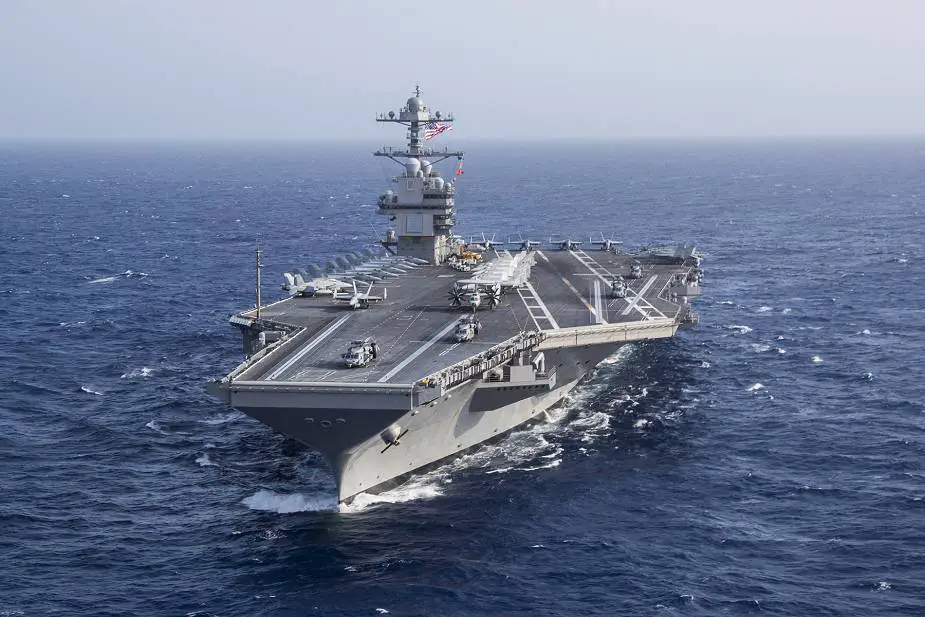Breaking news
Test and trials operations at sea for US Navy Carrier Air Wing 8 embarked on USS Gerald R Ford.
According to information released by the U.S. Navy on June 7, 2020, the Carrier Air Wing (CVW) 8 embarked on U.S. Navy USS Gerald R. Ford (CVN 78) aircraft carrier logged significant milestones this week during Post Delivery Test and Trials (PDT&T) operations at sea. The Carrier Air Wing Eight (CVW-8), is a United States Navy aircraft carrier air wing based at Naval Air Station Oceana, Virginia. The air wing is attached to the aircraft carrier USS Gerald R. Ford (CVN-78).
Follow Navy Recognition on Google News at this link
 The Ford-class aircraft carrier USS Gerald R. Ford (CVN 78) Transits the Atlantic Ocean, June 4, 2020. (Picture source U.S. Navy)
The Ford-class aircraft carrier USS Gerald R. Ford (CVN 78) Transits the Atlantic Ocean, June 4, 2020. (Picture source U.S. Navy)
During Ford’s largest aircraft embark to date, CVW-8 completed critical milestones on the first-in-class ship, testing secure communications and tactical data links, supporting the use of Network Enabled Weapons (NEW), Combined fixed- and rotary-wing Close Air Support integration, and SIMDIS, a multi-dimensional interactive graphical and video display to playback large events for debriefs.
Underway, CVW-8 conducted day and night cyclic flight operations totaling 324 catapult launches and arrested landings, qualifying 50 pilots, including Ford’s Commanding Officer, Capt. J.J. Cummings. To date, Ford has conducted 3,480 catapult launches and arrested landings with EMALS and AAG. Additionally, during this execution of cyclic flight operations with CVW-8, Ford moved thousands of pounds of inert ordnance via Advanced Weapons Elevators to F/A-18 Super Hornets, employed during Close Air Support and air-to-ground training missions. Executing cyclic operations and arming aircraft with bombs from the ship’s magazines were firsts for the team.
The air wing’s embark provided the first opportunity for Ford’s weapons department to execute a full ordnance movement using a lower stage weapons elevator. Performing as advertised, Ford’s AWEs conducted more than 1,300 cycles during this latest at sea period that enabled the successful transfer of 176 inert bombs in support of air wing operations. Ford's AWEs have conducted over 10,000 cycles to date.
Commander, Carrier Strike Group (CSG) 12 also embarked Ford during this underway, marking the first time a Strike Group Commander and staff embarked Ford for operations. CSG-12 was able to successfully conduct all intended command and control operations, control and distribute the link picture, and coordinate with Ford and Truman Strike Group assets as well as higher headquarters. Rear Adm. Craig Clapperton, commander, Carrier Strike Group (CSG) 12 assessed that the Strike Group and ship are ahead of schedule in this important command and control domain.

An F/A-18F Super Hornet attached to the "Black Lions" of Strike Fighter Squadron (VFA) 213 launches off USS Gerald R. Ford's (CVN 78) flight deck during flight operations June 7, 2020. (Picture source U.S. Navy)
The US Navy USS Gerald R. Ford CVN-78 aircraft carrier is able to carry up to 90 aircraft, including the Boeing F/A-18E/F Super Hornet, Boeing EA-18G Growler, Grumman C-2 Greyhound, Northrop Grumman E-2 Hawkeye, Lockheed Martin F-35C Lightning II, Sikorsky SH-60 Seahawk helicopters, and unmanned combat aerial vehicles.
The missions of Carrier Air Wing Eight (CVW-8) are to conduct carrier air warfare operations and assist in the planning, control, coordination and integration of nine air wing squadrons in support of carrier air warfare including; Interception and destruction of enemy aircraft and missiles in all-weather conditions to establish and maintain local air superiority. All-weather offensive air-to-surface attacks, Detection, localization, and destruction of enemy ships and submarines to establish and maintain local sea control.
The missions of CVW-8 also include Aerial photographic, sighting, and electronic intelligence for naval and joint operations. Airborne early warning service to fleet forces and shore warning nets. Airborne electronic countermeasures. In-flight refueling operations to extend the range and the endurance of air wing aircraft and Search and rescue operations.
The CVW-8 consists of 8 Squadrons including the VFA-34 with F/A-18E Super Hornet fighter, the VFA-37 with F/A-18E Super Hornet fighter, VFA-97 with F/A-18E Super Hornet fighter, VFA-213 with F/A-18E Super Hornet fighter, the VAW-124 with E-2C Hawkeye all-weather carrier-capable tactical airborne early warning (AEW) aircraft, the VAQ-131 with EA-18G Growler electronic warfare aircraft, the VRC-40 with C-2A Greyhound cargo aircraft, the HSC-90 with MH-60S Seahawk naval helicopters and the HSM-70 with MH-60R naval helicopters.


























